Shiwen Mao
Sherman
Low-Altitude UAV-Carried Movable Antenna for Joint Wireless Power Transfer and Covert Communications
Oct 30, 2025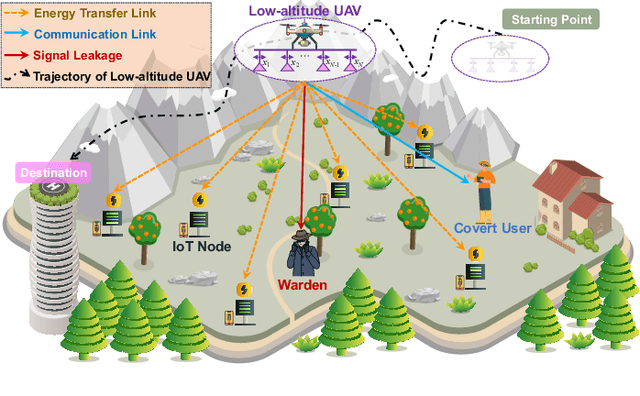
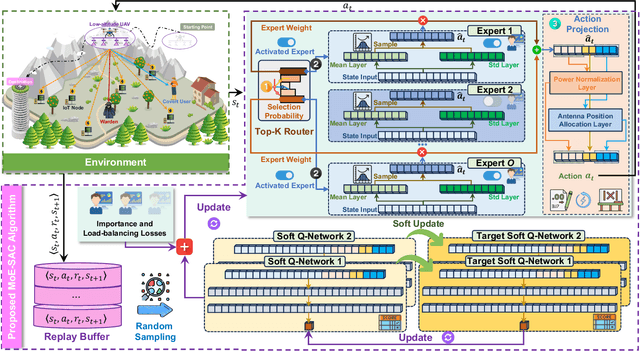
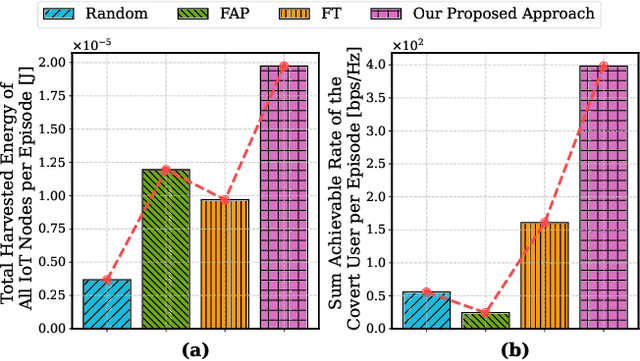
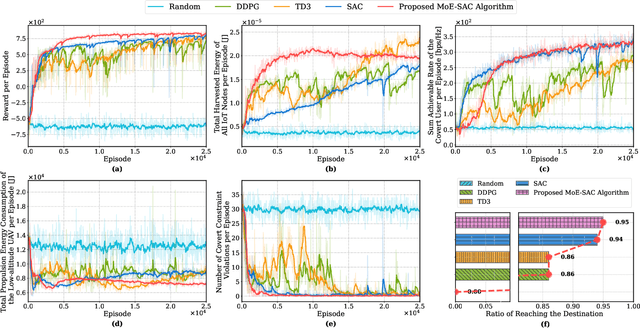
Abstract:The proliferation of Internet of Things (IoT) networks has created an urgent need for sustainable energy solutions, particularly for the battery-constrained spatially distributed IoT nodes. While low-altitude uncrewed aerial vehicles (UAVs) employed with wireless power transfer (WPT) capabilities offer a promising solution, the line-of-sight channels that facilitate efficient energy delivery also expose sensitive operational data to adversaries. This paper proposes a novel low-altitude UAV-carried movable antenna-enhanced transmission system joint WPT and covert communications, which simultaneously performs energy supplements to IoT nodes and establishes transmission links with a covert user by leveraging wireless energy signals as a natural cover. Then, we formulate a multi-objective optimization problem that jointly maximizes the total harvested energy of IoT nodes and sum achievable rate of the covert user, while minimizing the propulsion energy consumption of the low-altitude UAV. To address the non-convex and temporally coupled optimization problem, we propose a mixture-of-experts-augmented soft actor-critic (MoE-SAC) algorithm that employs a sparse Top-K gated mixture-of-shallow-experts architecture to represent multimodal policy distributions arising from the conflicting optimization objectives. We also incorporate an action projection module that explicitly enforces per-time-slot power budget constraints and antenna position constraints. Simulation results demonstrate that the proposed approach significantly outperforms some baseline approaches and other state-of-the-art deep reinforcement learning algorithms.
Optimizing Communication and Device Clustering for Clustered Federated Learning with Differential Privacy
Jul 09, 2025Abstract:In this paper, a secure and communication-efficient clustered federated learning (CFL) design is proposed. In our model, several base stations (BSs) with heterogeneous task-handling capabilities and multiple users with non-independent and identically distributed (non-IID) data jointly perform CFL training incorporating differential privacy (DP) techniques. Since each BS can process only a subset of the learning tasks and has limited wireless resource blocks (RBs) to allocate to users for federated learning (FL) model parameter transmission, it is necessary to jointly optimize RB allocation and user scheduling for CFL performance optimization. Meanwhile, our considered CFL method requires devices to use their limited data and FL model information to determine their task identities, which may introduce additional communication overhead. We formulate an optimization problem whose goal is to minimize the training loss of all learning tasks while considering device clustering, RB allocation, DP noise, and FL model transmission delay. To solve the problem, we propose a novel dynamic penalty function assisted value decomposed multi-agent reinforcement learning (DPVD-MARL) algorithm that enables distributed BSs to independently determine their connected users, RBs, and DP noise of the connected users but jointly minimize the training loss of all learning tasks across all BSs. Different from the existing MARL methods that assign a large penalty for invalid actions, we propose a novel penalty assignment scheme that assigns penalty depending on the number of devices that cannot meet communication constraints (e.g., delay), which can guide the MARL scheme to quickly find valid actions, thus improving the convergence speed. Simulation results show that the DPVD-MARL can improve the convergence rate by up to 20% and the ultimate accumulated rewards by 15% compared to independent Q-learning.
From Ground to Sky: Architectures, Applications, and Challenges Shaping Low-Altitude Wireless Networks
Jun 14, 2025Abstract:In this article, we introduce a novel low-altitude wireless network (LAWN), which is a reconfigurable, three-dimensional (3D) layered architecture. In particular, the LAWN integrates connectivity, sensing, control, and computing across aerial and terrestrial nodes that enable seamless operation in complex, dynamic, and mission-critical environments. In this article, we introduce a novel low-altitude wireless network (LAWN), which is a reconfigurable, three-dimensional (3D) layered architecture. Different from the conventional aerial communication systems, LAWN's distinctive feature is its tight integration of functional planes in which multiple functionalities continually reshape themselves to operate safely and efficiently in the low-altitude sky. With the LAWN, we discuss several enabling technologies, such as integrated sensing and communication (ISAC), semantic communication, and fully-actuated control systems. Finally, we identify potential applications and key cross-layer challenges. This article offers a comprehensive roadmap for future research and development in the low-altitude airspace.
LLM-guided DRL for Multi-tier LEO Satellite Networks with Hybrid FSO/RF Links
May 17, 2025Abstract:Despite significant advancements in terrestrial networks, inherent limitations persist in providing reliable coverage to remote areas and maintaining resilience during natural disasters. Multi-tier networks with low Earth orbit (LEO) satellites and high-altitude platforms (HAPs) offer promising solutions, but face challenges from high mobility and dynamic channel conditions that cause unstable connections and frequent handovers. In this paper, we design a three-tier network architecture that integrates LEO satellites, HAPs, and ground terminals with hybrid free-space optical (FSO) and radio frequency (RF) links to maximize coverage while maintaining connectivity reliability. This hybrid approach leverages the high bandwidth of FSO for satellite-to-HAP links and the weather resilience of RF for HAP-to-ground links. We formulate a joint optimization problem to simultaneously balance downlink transmission rate and handover frequency by optimizing network configuration and satellite handover decisions. The problem is highly dynamic and non-convex with time-coupled constraints. To address these challenges, we propose a novel large language model (LLM)-guided truncated quantile critics algorithm with dynamic action masking (LTQC-DAM) that utilizes dynamic action masking to eliminate unnecessary exploration and employs LLMs to adaptively tune hyperparameters. Simulation results demonstrate that the proposed LTQC-DAM algorithm outperforms baseline algorithms in terms of convergence, downlink transmission rate, and handover frequency. We also reveal that compared to other state-of-the-art LLMs, DeepSeek delivers the best performance through gradual, contextually-aware parameter adjustments.
Decentralization of Generative AI via Mixture of Experts for Wireless Networks: A Comprehensive Survey
Apr 28, 2025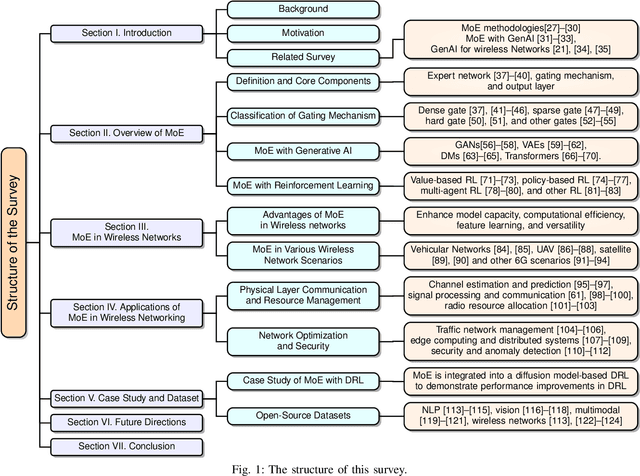
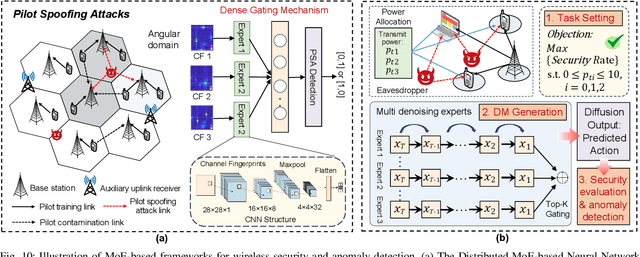
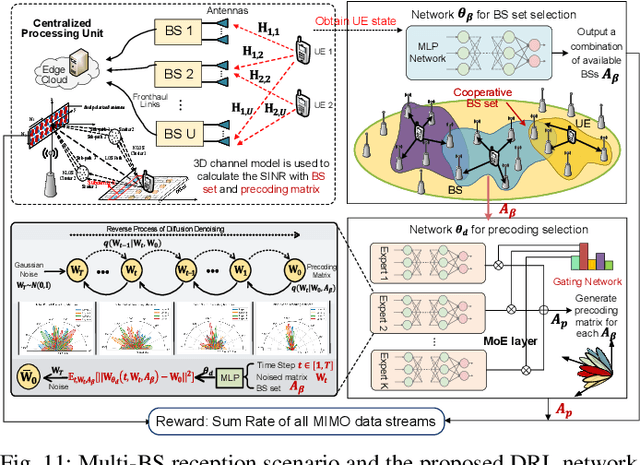
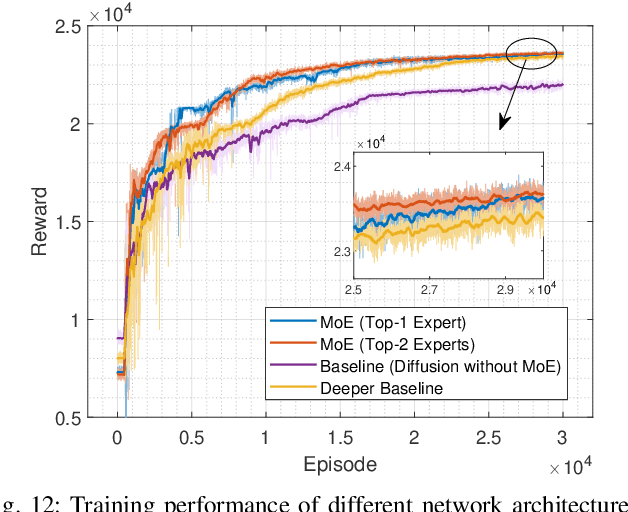
Abstract:Mixture of Experts (MoE) has emerged as a promising paradigm for scaling model capacity while preserving computational efficiency, particularly in large-scale machine learning architectures such as large language models (LLMs). Recent advances in MoE have facilitated its adoption in wireless networks to address the increasing complexity and heterogeneity of modern communication systems. This paper presents a comprehensive survey of the MoE framework in wireless networks, highlighting its potential in optimizing resource efficiency, improving scalability, and enhancing adaptability across diverse network tasks. We first introduce the fundamental concepts of MoE, including various gating mechanisms and the integration with generative AI (GenAI) and reinforcement learning (RL). Subsequently, we discuss the extensive applications of MoE across critical wireless communication scenarios, such as vehicular networks, unmanned aerial vehicles (UAVs), satellite communications, heterogeneous networks, integrated sensing and communication (ISAC), and mobile edge networks. Furthermore, key applications in channel prediction, physical layer signal processing, radio resource management, network optimization, and security are thoroughly examined. Additionally, we present a detailed overview of open-source datasets that are widely used in MoE-based models to support diverse machine learning tasks. Finally, this survey identifies crucial future research directions for MoE, emphasizing the importance of advanced training techniques, resource-aware gating strategies, and deeper integration with emerging 6G technologies.
Aerial Active STAR-RIS-assisted Satellite-Terrestrial Covert Communications
Apr 22, 2025Abstract:An integration of satellites and terrestrial networks is crucial for enhancing performance of next generation communication systems. However, the networks are hindered by the long-distance path loss and security risks in dense urban environments. In this work, we propose a satellite-terrestrial covert communication system assisted by the aerial active simultaneous transmitting and reflecting reconfigurable intelligent surface (AASTAR-RIS) to improve the channel capacity while ensuring the transmission covertness. Specifically, we first derive the minimal detection error probability (DEP) under the worst condition that the Warden has perfect channel state information (CSI). Then, we formulate an AASTAR-RIS-assisted satellite-terrestrial covert communication optimization problem (ASCCOP) to maximize the sum of the fair channel capacity for all ground users while meeting the strict covert constraint, by jointly optimizing the trajectory and active beamforming of the AASTAR-RIS. Due to the challenges posed by the complex and high-dimensional state-action spaces as well as the need for efficient exploration in dynamic environments, we propose a generative deterministic policy gradient (GDPG) algorithm, which is a generative deep reinforcement learning (DRL) method to solve the ASCCOP. Concretely, the generative diffusion model (GDM) is utilized as the policy representation of the algorithm to enhance the exploration process by generating diverse and high-quality samples through a series of denoising steps. Moreover, we incorporate an action gradient mechanism to accomplish the policy improvement of the algorithm, which refines the better state-action pairs through the gradient ascent. Simulation results demonstrate that the proposed approach significantly outperforms important benchmarks.
Fusing Bluetooth with Pedestrian Dead Reckoning: A Floor Plan-Assisted Positioning Approach
Apr 14, 2025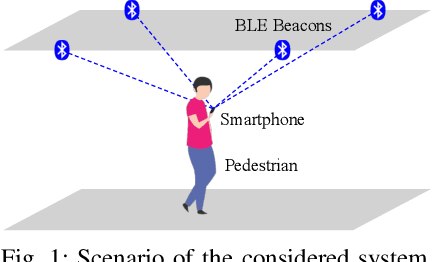
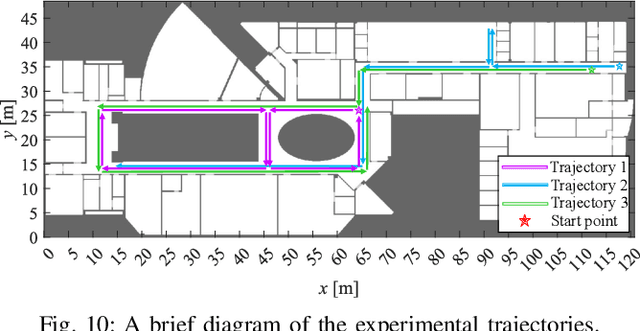
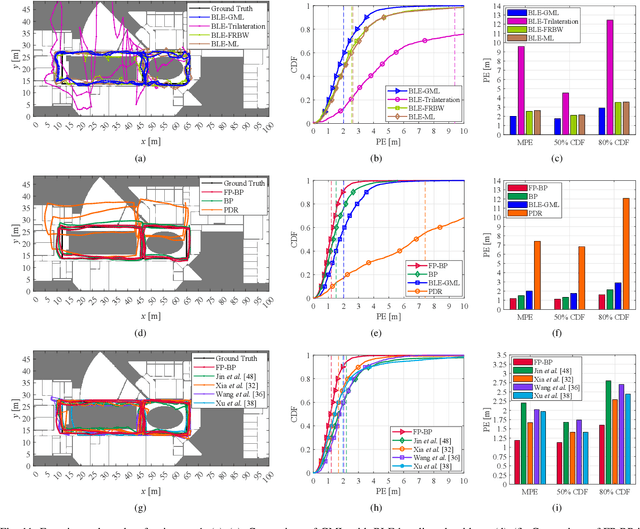
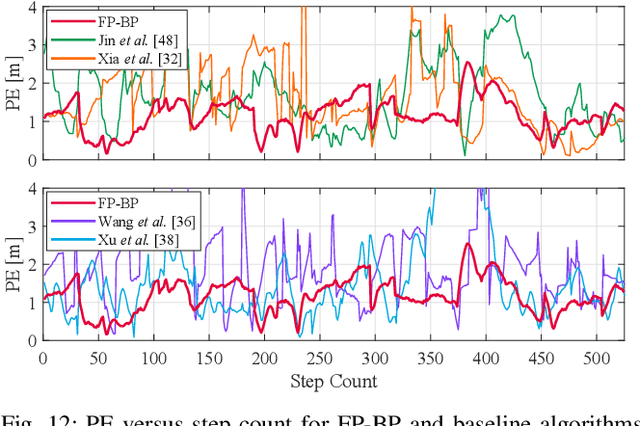
Abstract:Floor plans can provide valuable prior information that helps enhance the accuracy of indoor positioning systems. However, existing research typically faces challenges in efficiently leveraging floor plan information and applying it to complex indoor layouts. To fully exploit information from floor plans for positioning, we propose a floor plan-assisted fusion positioning algorithm (FP-BP) using Bluetooth low energy (BLE) and pedestrian dead reckoning (PDR). In the considered system, a user holding a smartphone walks through a positioning area with BLE beacons installed on the ceiling, and can locate himself in real time. In particular, FP-BP consists of two phases. In the offline phase, FP-BP programmatically extracts map features from a stylized floor plan based on their binary masks, and constructs a mapping function to identify the corresponding map feature of any given position on the map. In the online phase, FP-BP continuously computes BLE positions and PDR results from BLE signals and smartphone sensors, where a novel grid-based maximum likelihood estimation (GML) algorithm is introduced to enhance BLE positioning. Then, a particle filter is used to fuse them and obtain an initial estimate. Finally, FP-BP performs post-position correction to obtain the final position based on its specific map feature. Experimental results show that FP-BP can achieve a real-time mean positioning accuracy of 1.19 m, representing an improvement of over 28% compared to existing floor plan-fused baseline algorithms.
Joint Transmit Waveform and Receive Filter Design for ISAC System with Jamming
Apr 11, 2025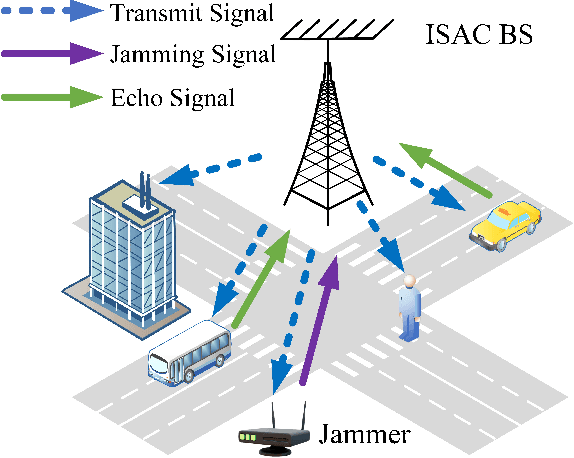
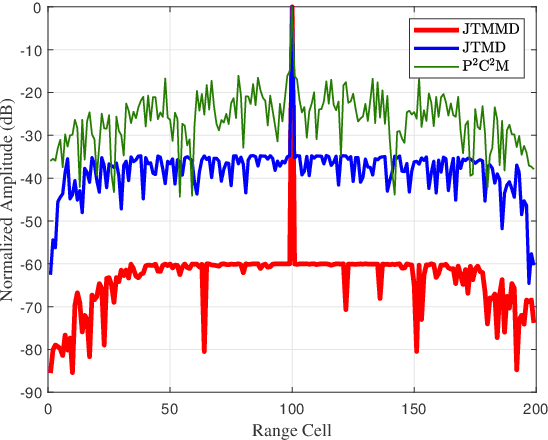
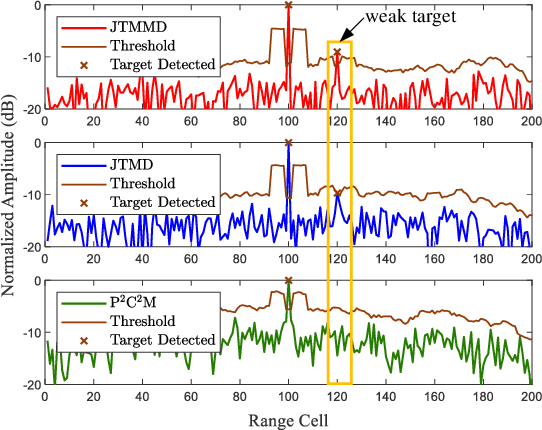
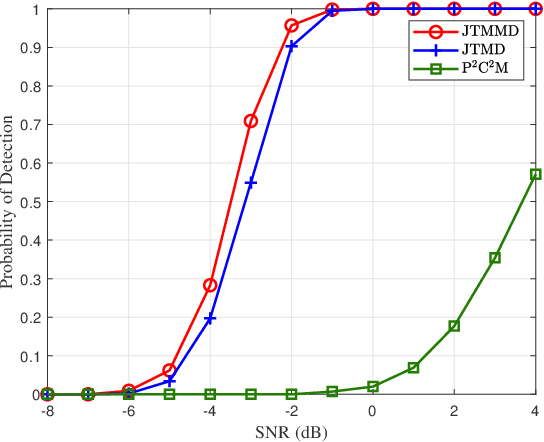
Abstract:In this paper, to suppress jamming in the complex electromagnetic environment, we propose a joint transmit waveform and receive filter design framework for integrated sensing and communications (ISAC). By jointly optimizing the transmit waveform and receive filters, we aim at minimizing the multiuser interference (MUI), subject to the constraints of the target mainlobe, jamming mainlobe and peak sidelobe level of the receive filter output as well as the transmit power of the ISAC base station. We propose two schemes to solve the problem, including joint transmit waveform and matched filter design (JTMD) and joint transmit waveform and mismatched filter design (JTMMD) schemes. For both schemes, we adopt the alternating direction method of multipliers to iteratively optimize the transmit waveform and receive filters, where the number of targets as well as the range and angles of each target can also be estimated. Simulation results show that both the JTMD and JTMMD schemes achieve superior performance in terms of communication MUI and radar detection performance.
Wireless Hallucination in Generative AI-enabled Communications: Concepts, Issues, and Solutions
Mar 08, 2025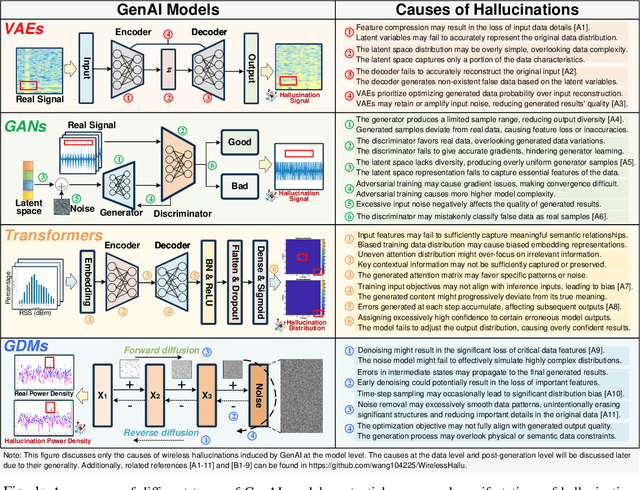
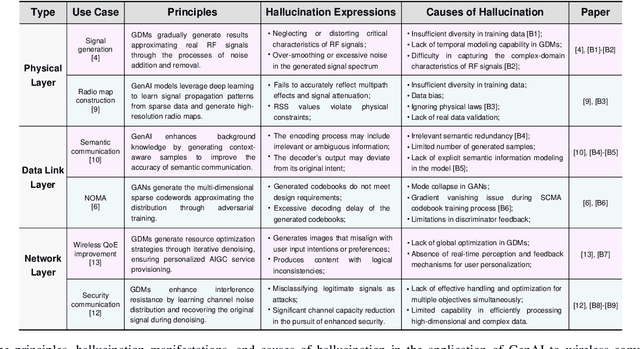
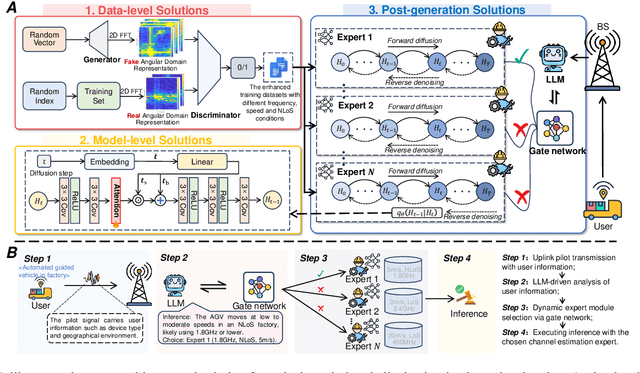

Abstract:Generative AI (GenAI) is driving the intelligence of wireless communications. Due to data limitations, random generation, and dynamic environments, GenAI may generate channel information or optimization strategies that violate physical laws or deviate from actual real-world requirements. We refer to this phenomenon as wireless hallucination, which results in invalid channel information, spectrum wastage, and low communication reliability but remains underexplored. To address this gap, this article provides a comprehensive concept of wireless hallucinations in GenAI-driven communications, focusing on hallucination mitigation. Specifically, we first introduce the fundamental, analyze its causes based on the GenAI workflow, and propose mitigation solutions at the data, model, and post-generation levels. Then, we systematically examines representative hallucination scenarios in GenAI-enabled communications and their corresponding solutions. Finally, we propose a novel integrated mitigation solution for GenAI-based channel estimation. At the data level, we establish a channel estimation hallucination dataset and employ generative adversarial networks (GANs)-based data augmentation. Additionally, we incorporate attention mechanisms and large language models (LLMs) to enhance both training and inference performance. Experimental results demonstrate that the proposed hybrid solutions reduce the normalized mean square error (NMSE) by 0.19, effectively reducing wireless hallucinations.
Toward Agentic AI: Generative Information Retrieval Inspired Intelligent Communications and Networking
Feb 24, 2025Abstract:The increasing complexity and scale of modern telecommunications networks demand intelligent automation to enhance efficiency, adaptability, and resilience. Agentic AI has emerged as a key paradigm for intelligent communications and networking, enabling AI-driven agents to perceive, reason, decide, and act within dynamic networking environments. However, effective decision-making in telecom applications, such as network planning, management, and resource allocation, requires integrating retrieval mechanisms that support multi-hop reasoning, historical cross-referencing, and compliance with evolving 3GPP standards. This article presents a forward-looking perspective on generative information retrieval-inspired intelligent communications and networking, emphasizing the role of knowledge acquisition, processing, and retrieval in agentic AI for telecom systems. We first provide a comprehensive review of generative information retrieval strategies, including traditional retrieval, hybrid retrieval, semantic retrieval, knowledge-based retrieval, and agentic contextual retrieval. We then analyze their advantages, limitations, and suitability for various networking scenarios. Next, we present a survey about their applications in communications and networking. Additionally, we introduce an agentic contextual retrieval framework to enhance telecom-specific planning by integrating multi-source retrieval, structured reasoning, and self-reflective validation. Experimental results demonstrate that our framework significantly improves answer accuracy, explanation consistency, and retrieval efficiency compared to traditional and semantic retrieval methods. Finally, we outline future research directions.
 Add to Chrome
Add to Chrome Add to Firefox
Add to Firefox Add to Edge
Add to Edge